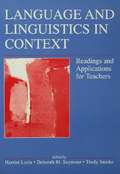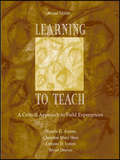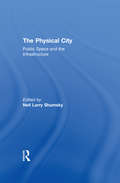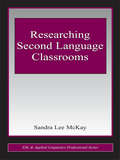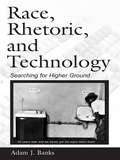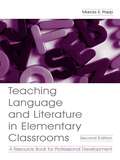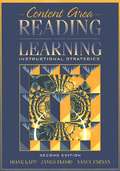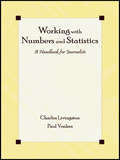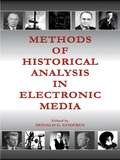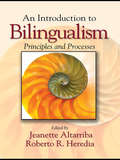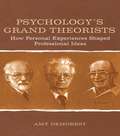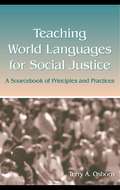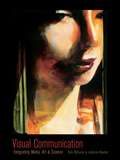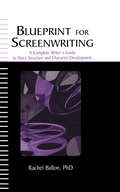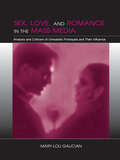- Table View
- List View
Language and Linguistics in Context: Readings and Applications for Teachers
by Harriet Luria Deborah M. Seymour Trudy SmokeTaking a sociocultural and educational approach, Language and Linguistics in Context: Readings and Applications for Teachers:*introduces basic linguistic concepts and current perspectives on language acquisition;*considers the role of linguistic change (especially in English) in the politics of language;*acknowledges the role of linguists in current policies involving language; *offers insights into the relationship between the structure of language systems and first- and second-language acquisition; the study of language across culture, class, race, gender, and ethnicity; and between language study and literacy and education; and*provides readers with a basis for understanding current educational debates about bilingual education, non-standard dialects, English only movements, literacy methodologies, and generally the importance to teaching of the study of language. The text is organized into three thematic units – "What is Language and How is It Acquired?"; "How Does Language Change?"; and "What is Literacy?". To achieve both breadth and depth – that is, to provide a “big picture” view of basic linguistics and at the same time make it specific enough for the beginner – a selection of readings, including personal language narratives, is provided to both introduce and clarify linguistic concepts. The readings, by well-known theoretical and applied linguists and researchers from various disciplines, are diverse in level and range of topics and vary in level of linguistic formalism. Pedagogical features: This text is designed for a range of courses in English and language arts, bilingualism, applied linguistics, and ESL courses in teacher education programs. Each unit contains a substantive introduction to the topic, followed by the readings. Each reading concludes with Questions to Think About including one Extending Your Understanding question, and a short list of Terms to Define. Each unit ends with additional Extending Your Understanding and Making Connections activities that engage readers in applying what they have read to teaching and suggested projects and a bibliography of Print and Web Resources. The readings and apparatus are arranged so that the material can be modified to fit many course plans and schemes of presentation. To help individual instructors make the most effective use of the text in specific classes, a set of matrixes is provided suggesting configurations of readings for different types of linguistics and education classes.
Learning to Teach: A Critical Approach to Field Experiences
by Natalie G. Adams Christine Mary Shea Delores D. Liston Bryan DeeverThis text is designed to assist preservice and inservice teachers in creating a critical and reflective dialogue with themselves, their assigned classroom cultures, and the larger school environment. It engages readers in a series of classroom and school-based activities, observations, and exercises that can be used in any teacher education course with a field component. Different from other field experience guides, this text aims to disrupt traditional conceptions of teacher education and field experiences--by emphasizing the problematic nature and dynamics of public schooling, and encouraging readers to seek a greater awareness of their own attitudes toward and connections with these educational processes.Learning to Teach: A Critical Approach to the Field Experience, Second Edition:*dramatically reconceptualizes the field experience by asking preservice and inservice teachers to be active and critical researchers of classroom practices and processes;*provides a coherent framework for analyzing both structural and cultural aspects of schooling;*provides specific exercises to help preservice and inservice teachers evaluate and understand the intersections of race, class, gender, and culture in "real life" school settings; and*grounds the observations of everyday school life within critical, feminist, and poststructuralist discourses.New in the Second Edition: A new section,"No Child Left Untested," has been added to help preservice teachers explore the implications of a very changed post-September 11world in which xenophobia, violence, patriotism, citizenship, and democracy have taken on new meanings. The introduction to the book as a whole, the section introductions, the retained activities in existing sections, and the references have been throughly updated.
The Physical City: Public Space and the Infrastructure
by Neil L. ShumskyFirst Published in 1996. Routledge is an imprint of Taylor & Francis, an informa company.
The Physical City: Public Space and the Infrastructure
by Neil L. ShumskyFirst Published in 1996. Routledge is an imprint of Taylor & Francis, an informa company.
Researching Second Language Classrooms
by Sandra Lee MckayThis text introduces teachers to research methods they can use to examine their own classrooms in order to become more effective teachers. Becoming familiar with classroom-based research methods not only enables teachers to do research in their own classrooms, it also provides a basis for assessing the findings of existing research. McKay emphasizes throughout that what a teacher chooses to examine will dictate which method is most effective. Each chapter includes activities to help readers apply the methods described in the chapter, often by analyzing research data.*Chapter I, Classroom Research, introduces the reader to major research purposes and research types as they relate to classroom research, the distinction between quantitative and qualitative research, the formulation of research questions and research designs, and ethical issues in research.*Chapter II, Researching Teachers and Learners, presents research methods that can be used to examine teachers' and learners' attitudes and behaviors: action research, survey research, interviews, verbal reports, diary studies, case studies, and ethnographies.*Chapter III, Researching Classroom Discourse, deals with methods that can be used to study the oral and written discourse of classrooms: interaction analysis, discourse analysis, text analysis, and ways to examine the social and political assumptions underlying the choice and presentation of content in second language teaching materials.*Chapter IV, Writing Research Reports, provides guidelines for both thesis writing and journal articles.Researching Second Language Classrooms is an ideal text for TESOL research methods courses and an essential resource for inservice teachers who wish to undertake classroom research.
Researching Second Language Classrooms
by Sandra Lee MckayThis text introduces teachers to research methods they can use to examine their own classrooms in order to become more effective teachers. Becoming familiar with classroom-based research methods not only enables teachers to do research in their own classrooms, it also provides a basis for assessing the findings of existing research. McKay emphasizes throughout that what a teacher chooses to examine will dictate which method is most effective. Each chapter includes activities to help readers apply the methods described in the chapter, often by analyzing research data.*Chapter I, Classroom Research, introduces the reader to major research purposes and research types as they relate to classroom research, the distinction between quantitative and qualitative research, the formulation of research questions and research designs, and ethical issues in research.*Chapter II, Researching Teachers and Learners, presents research methods that can be used to examine teachers' and learners' attitudes and behaviors: action research, survey research, interviews, verbal reports, diary studies, case studies, and ethnographies.*Chapter III, Researching Classroom Discourse, deals with methods that can be used to study the oral and written discourse of classrooms: interaction analysis, discourse analysis, text analysis, and ways to examine the social and political assumptions underlying the choice and presentation of content in second language teaching materials.*Chapter IV, Writing Research Reports, provides guidelines for both thesis writing and journal articles.Researching Second Language Classrooms is an ideal text for TESOL research methods courses and an essential resource for inservice teachers who wish to undertake classroom research.
Race, Rhetoric, and Technology: Searching for Higher Ground
by Adam J. BanksIn this book Adam Banks uses the concept of the Digital Divide as a metonym for America's larger racial divide, in an attempt to figure out what meaningful access for African Americans to technologies and the larger American society can or should mean. He argues that African American rhetorical traditions--the traditions of struggle for justice and equitable participation in American society--exhibit complex and nuanced ways of understanding the difficulties inherent in the attempt to navigate through the seemingly impossible contradictions of gaining meaningful access to technological systems with the good they seem to make possible, and at the same time resisting the exploitative impulses that such systems always seem to present.Banks examines moments in these rhetorical traditions of appeals, warnings, demands, and debates to make explicit the connections between technological issues and African Americans' equal and just participation in American society. He shows that the big questions we must ask of our technologies are exactly the same questions leaders and lay people from Martin Luther King to Malcolm X to slave quilters to Critical Race Theorists to pseudonymous chatters across cyberspace have been asking all along. According to Banks the central ethical questions for the field of rhetoric and composition are technology access and the ability to address questions of race and racism. He uses this book to imagine what writing instruction, technology theory, literacy instruction, and rhetorical education can look like for all of us in a new century.Just as Race, Rhetoric, and Technology: Searching for Higher Ground is a call for a new orientation among those who study and profess African American rhetoric, it is also a call for those in the fields that make up mainstream English Studies to change their perspectives as well. This volume is intended for researchers, professionals, and students in Rhetoric and Composition, Technical Communication, the History of Science and Society, and African American Studies.
Race, Rhetoric, and Technology: Searching for Higher Ground
by Adam J. BanksIn this book Adam Banks uses the concept of the Digital Divide as a metonym for America's larger racial divide, in an attempt to figure out what meaningful access for African Americans to technologies and the larger American society can or should mean. He argues that African American rhetorical traditions--the traditions of struggle for justice and equitable participation in American society--exhibit complex and nuanced ways of understanding the difficulties inherent in the attempt to navigate through the seemingly impossible contradictions of gaining meaningful access to technological systems with the good they seem to make possible, and at the same time resisting the exploitative impulses that such systems always seem to present.Banks examines moments in these rhetorical traditions of appeals, warnings, demands, and debates to make explicit the connections between technological issues and African Americans' equal and just participation in American society. He shows that the big questions we must ask of our technologies are exactly the same questions leaders and lay people from Martin Luther King to Malcolm X to slave quilters to Critical Race Theorists to pseudonymous chatters across cyberspace have been asking all along. According to Banks the central ethical questions for the field of rhetoric and composition are technology access and the ability to address questions of race and racism. He uses this book to imagine what writing instruction, technology theory, literacy instruction, and rhetorical education can look like for all of us in a new century.Just as Race, Rhetoric, and Technology: Searching for Higher Ground is a call for a new orientation among those who study and profess African American rhetoric, it is also a call for those in the fields that make up mainstream English Studies to change their perspectives as well. This volume is intended for researchers, professionals, and students in Rhetoric and Composition, Technical Communication, the History of Science and Society, and African American Studies.
Teaching Language and Literature in Elementary Classrooms: A Resource Book for Professional Development
by Marcia S. PoppThe goal of this book -- a theoretically based, well-organized, useful guide for teaching -- is to help the beginning teacher create a classroom environment that integrates literacy development with learning in all areas of the curriculum. The major components of an integrated language program are identified, and the skills teachers need to implement this kind of program in their own classrooms are described. Designed to be kept and used as a resource in the classroom, this text provides fundamental information about language arts teaching. A constructivist orientation, an emphasis on teachers as reflective decision makers, and vivid portrayals of the classroom as a community of learners and inquirers are woven throughout the book. Key features include: * a wealth of models, suggestions, and step-by-step guidelines for introducing integrated teaching and learning practices into elementary classrooms at the kindergarten, primary, and intermediate levels; * a focus on relevant research in language arts and professional teacher development; * true-to-life classroom narratives that model instructional strategies and demonstrate interactions between real teachers and students; and * an innovative chapter format that makes the text accessible as a resource for student, beginning, and experienced teachers.
Content Area Reading and Learning: Instructional Strategies
by Diane Lapp James Flood Nancy FarnanHow can teachers make content-area learning more accessible to their students? This text addresses instructional issues and provides a wealth of classroom strategies to help all middle and secondary teachers effectively enable their students to develop both content concepts and strategies for continued learning. The goal is to help teachers model, through excellent instruction, the importance of lifelong content-area learning. This working textbook provides students maximum interaction with the information, strategies, and examples presented in each chapter. Content Area Reading and Learning: Instructional Strategies, Third Edition is organized around five themes: Content Area Reading: An Overview The Teacher and the Text The Students The Instructional Program School Culture and Environment in Middle and High School Classrooms Pedagogical features: Each chapter includes a graphic organizer, a chapter overview, a Think Before Reading Activity, one or more Think While Reading Activities, and a Think After Reading Activity. The activities present questions and scenarios designed to integrate students’ previous knowledge and experience with their new learnings about issues related to content area reading, literacy, and learning, and to serve as catalysts for thinking and discussions. New in the Third Edition The latest information on literacy strategies in every content area Research-based strategies for teaching students to read informational texts Up-to-date information for differentiating instruction for English-speaking and non-English speaking students An examination of youth culture and the role it plays in student learning A look at authentic learning in contexts related to the world of work Ways of using technology and media literacy to support content learning Suggestions for using writing in every content area to enhance student learning Ideas for using multiple texts for learning content A focus on the assessment-instruction connection Strategies for engaging and motivating students Content Area Reading and Learning: Instructional Strategies, Third Edition, is intended as a primary text for courses on middle and high school content area literacy and learning.
Content Area Reading and Learning: Instructional Strategies
by Diane Lapp James Flood Nancy FarnanHow can teachers make content-area learning more accessible to their students? This text addresses instructional issues and provides a wealth of classroom strategies to help all middle and secondary teachers effectively enable their students to develop both content concepts and strategies for continued learning. The goal is to help teachers model, through excellent instruction, the importance of lifelong content-area learning. This working textbook provides students maximum interaction with the information, strategies, and examples presented in each chapter. Content Area Reading and Learning: Instructional Strategies, Third Edition is organized around five themes: Content Area Reading: An Overview The Teacher and the Text The Students The Instructional Program School Culture and Environment in Middle and High School Classrooms Pedagogical features: Each chapter includes a graphic organizer, a chapter overview, a Think Before Reading Activity, one or more Think While Reading Activities, and a Think After Reading Activity. The activities present questions and scenarios designed to integrate students’ previous knowledge and experience with their new learnings about issues related to content area reading, literacy, and learning, and to serve as catalysts for thinking and discussions. New in the Third Edition The latest information on literacy strategies in every content area Research-based strategies for teaching students to read informational texts Up-to-date information for differentiating instruction for English-speaking and non-English speaking students An examination of youth culture and the role it plays in student learning A look at authentic learning in contexts related to the world of work Ways of using technology and media literacy to support content learning Suggestions for using writing in every content area to enhance student learning Ideas for using multiple texts for learning content A focus on the assessment-instruction connection Strategies for engaging and motivating students Content Area Reading and Learning: Instructional Strategies, Third Edition, is intended as a primary text for courses on middle and high school content area literacy and learning.
Working With Numbers and Statistics: A Handbook for Journalists
by Charles Livingston Paul S. VoakesWorking With Numbers and Statistics: A Handbook for Journalists will bolster math skills and improve math confidence for journalists at all skill levels. Authors Charles Livingston and Paul Voakes developed this resource book to improve journalistic writing and reporting, enabling journalists to:*make accurate, reliable computations, which in turn enables one to make relevant comparisons, put facts into perspective, and lend important context to stories;*recognize inaccurate presentations, whether willfully spun or just carelessly relayed;*ask appropriate questions about numerical matters;*translate complicated numbers for viewers and readers in ways they can readily understand;*understand computer-assisted reporting; and*write livelier, more precise pieces through the use of numbers.The math is presented in a journalistic context throughout, enabling readers to see how the procedures will come into play in their work.Working With Numbers and Statistics is designed as a reference work for journalism students developing their writing and reporting skills. It will also serve professionals as a useful tool to improve their understanding and use of numbers in news stories.
Working With Numbers and Statistics: A Handbook for Journalists
by Charles Livingston Paul S. VoakesWorking With Numbers and Statistics: A Handbook for Journalists will bolster math skills and improve math confidence for journalists at all skill levels. Authors Charles Livingston and Paul Voakes developed this resource book to improve journalistic writing and reporting, enabling journalists to:*make accurate, reliable computations, which in turn enables one to make relevant comparisons, put facts into perspective, and lend important context to stories;*recognize inaccurate presentations, whether willfully spun or just carelessly relayed;*ask appropriate questions about numerical matters;*translate complicated numbers for viewers and readers in ways they can readily understand;*understand computer-assisted reporting; and*write livelier, more precise pieces through the use of numbers.The math is presented in a journalistic context throughout, enabling readers to see how the procedures will come into play in their work.Working With Numbers and Statistics is designed as a reference work for journalism students developing their writing and reporting skills. It will also serve professionals as a useful tool to improve their understanding and use of numbers in news stories.
Methods of Historical Analysis in Electronic Media (Routledge Communication Series)
by Donald G. GodfreyMethods of Historical Analysis in Electronic Media provides a foundation for historical research in electronic media by addressing the literature and the methods--traditional and the eclectic methods of scholarship as applied to electronic media. It is about history--broadcast electronic media history and history that has been broadcast, and also about the historiography, research written, and the research yet to be written.Divided into five parts, this book:*addresses the challenges in the application of the historical methods to broadcast history;*reviews the various methods appropriate for electronic-media research based on the nature of the object under study;*suggests new approaches to popular historical topics;*takes a broad topical look at history in broadcasting; and*provides a broad overview of what has been accomplished, a historian's challenges, and future research.Intended for students and researchers in broadcast history, Methods of Historical Analysis in Electronic Media provides an understanding of the qualitative methodological tools necessary for the study of electronic media history, and illustrates how to find primary sources for electronic media research.
An Introduction to Bilingualism: Principles and Processes
by Jeanette Altarriba Roberto R. HerediaThis important text provides a general overview of the methods and theories used in the broad domain of bilingualism. The unique interdisciplinary approach, which is reflected in the various topics covered, gives students a global picture of the field. Topics range from early childhood intellectual development to educational and social-cognitive challenges to the maturing bilingual brain. Important developing areas such as cognitive aging, creativity, the social and cultural context perspective, communication disorders and sentence processing are also covered within the volume. This text is aimed towards undergraduate courses and graduate courses in psycholinguistics, especially those with an emphasis on bilingualism or second language learning.
An Introduction to Bilingualism: Principles and Processes
by Jeanette Altarriba Roberto R. HerediaThis important text provides a general overview of the methods and theories used in the broad domain of bilingualism. The unique interdisciplinary approach, which is reflected in the various topics covered, gives students a global picture of the field. Topics range from early childhood intellectual development to educational and social-cognitive challenges to the maturing bilingual brain. Important developing areas such as cognitive aging, creativity, the social and cultural context perspective, communication disorders and sentence processing are also covered within the volume. This text is aimed towards undergraduate courses and graduate courses in psycholinguistics, especially those with an emphasis on bilingualism or second language learning.
Psychology's Grand Theorists: How Personal Experiences Shaped Professional Ideas
by Amy P. DemorestPsychology's Grand Theorists argues that the three schools in psychology that have been dominant historically--the psychodynamic, behavioral, and phenomenological--have resulted in large part from the personal experiences of their originators. Sigmund Freud, B.F. Skinner, and Carl Rogers each believed that he had discovered the truth about human nature, yet their truths are entirely different. This book explores how the lives of these men influenced the divergent theories they developed, through a close examination of letters, diaries, biographies, autobiographies, and professional writings. Uncovering the subjective sources of these theories, the book gives the reader a greater sense of intimacy with each man's ideas, and promotes critical inquiry into their scientific status. The book is written in an engaging style that will appeal to a wide range of readers. Intended as a supplement in courses on personality, clinical psychology, and/or the history of psychology, it will also be of interest to clinicians or counselors who use one or more of these theoretical models in their therapeutic work.
Psychology's Grand Theorists: How Personal Experiences Shaped Professional Ideas
by Amy P. DemorestPsychology's Grand Theorists argues that the three schools in psychology that have been dominant historically--the psychodynamic, behavioral, and phenomenological--have resulted in large part from the personal experiences of their originators. Sigmund Freud, B.F. Skinner, and Carl Rogers each believed that he had discovered the truth about human nature, yet their truths are entirely different. This book explores how the lives of these men influenced the divergent theories they developed, through a close examination of letters, diaries, biographies, autobiographies, and professional writings. Uncovering the subjective sources of these theories, the book gives the reader a greater sense of intimacy with each man's ideas, and promotes critical inquiry into their scientific status. The book is written in an engaging style that will appeal to a wide range of readers. Intended as a supplement in courses on personality, clinical psychology, and/or the history of psychology, it will also be of interest to clinicians or counselors who use one or more of these theoretical models in their therapeutic work.
Teaching World Languages for Social Justice: A Sourcebook of Principles and Practices
by Terry A. OsbornTeaching World Languages for Social Justice: A Sourcebook of Principles and Practices offers principles based on theory, and innovative concepts, approaches, and practices illustrated through concrete examples, for promoting social justice and developing a critical praxis in foreign language classrooms in the U.S. and in wider world language communities. For educators seeking to translate these ideals into classroom practice in an environment dominated by the current standards movement and accountability measures, the critical insights on language education offered in this text will be widely welcomed.The text is designed as a sourcebook for translating theory into practice. Each chapter includes the theoretical base, guidelines for practice, discussion of the relationship to existing practices in the world language classroom, suggestions for activity development (which can be integrated into a professional portfolio), illustrative examples, questions for reflection, and additional suggested readings.Teaching World Languages for Social Justice is a primary or supplementary text for second and foreign language teaching methods courses and is equally appropriate for graduate courses in language education or educational studies.
Teaching World Languages for Social Justice: A Sourcebook of Principles and Practices
by Terry A. OsbornTeaching World Languages for Social Justice: A Sourcebook of Principles and Practices offers principles based on theory, and innovative concepts, approaches, and practices illustrated through concrete examples, for promoting social justice and developing a critical praxis in foreign language classrooms in the U.S. and in wider world language communities. For educators seeking to translate these ideals into classroom practice in an environment dominated by the current standards movement and accountability measures, the critical insights on language education offered in this text will be widely welcomed.The text is designed as a sourcebook for translating theory into practice. Each chapter includes the theoretical base, guidelines for practice, discussion of the relationship to existing practices in the world language classroom, suggestions for activity development (which can be integrated into a professional portfolio), illustrative examples, questions for reflection, and additional suggested readings.Teaching World Languages for Social Justice is a primary or supplementary text for second and foreign language teaching methods courses and is equally appropriate for graduate courses in language education or educational studies.
Visual Communication: Integrating Media, Art, and Science
by Rick Williams Julianne NewtonA well-rounded education in the 21st century requires not just verbal and mathematical proficiency, but also the ability to interpret, critique, create, and use visual communication on sophisticated levels. In today’s visual world, it is critically important to hold an appreciation for the profound effects imagery has on individuals and the communities in which they live. Visual Communication focuses on cultivating visual and media literacy from both consumption and production points of view and introduces students to the application of intuitive intelligence to a visual context. Innovative in its field, it provides a solid theoretical overview of the most advanced thinking and research about visual communication, teaching readers how to apply theory to enhance their understanding of and work with images. This book is intended for students in visual literacy and communication courses. It can also be used in photojournalism courses and other coursework with a visual component. Individuals interested in mass media studies will likewise find the book to be a worthwhile read.
Visual Communication: Integrating Media, Art, and Science
by Rick Williams Julianne NewtonA well-rounded education in the 21st century requires not just verbal and mathematical proficiency, but also the ability to interpret, critique, create, and use visual communication on sophisticated levels. In today’s visual world, it is critically important to hold an appreciation for the profound effects imagery has on individuals and the communities in which they live. Visual Communication focuses on cultivating visual and media literacy from both consumption and production points of view and introduces students to the application of intuitive intelligence to a visual context. Innovative in its field, it provides a solid theoretical overview of the most advanced thinking and research about visual communication, teaching readers how to apply theory to enhance their understanding of and work with images. This book is intended for students in visual literacy and communication courses. It can also be used in photojournalism courses and other coursework with a visual component. Individuals interested in mass media studies will likewise find the book to be a worthwhile read.
Blueprint for Screenwriting: A Complete Writer's Guide to Story Structure and Character Development
by Rachel BallonBlueprint for Screenwriting demystifies the writing process by developing a "blueprint" for writers to follow for each new screenplay--from original concept to completed script. Author and international script consultant Dr. Rachel Ballon explores the writing craft and emphasizes creativity in the writing process. She blends her expertise in script analysis and writing coaching with her personal experience as a screenwriter to help writers construct their stories and characters.Starting with the story's framework, Dr. Ballon helps readers to understand the key "building blocks" of story structure and character development, including characters' emotional and psychological states, story conflicts, and scene and act structure. She also covers the essential components in the script writing process, such as outlines, script treatments, synopses, and formats. Dr. Ballon devotes a chapter to overcoming writer's block--the writer's greatest obstacle--and offers guidance for taking the next steps once a script is completed.A practical tool for any writer, this distinctive resource:*offers a blueprint for writers to follow, breaking the writing process down into specific, easy-to-follow steps;*stresses the psychology of the characters as well as that of the writer; and*offers first-hand knowledge of the screenwriting process and gives practical advice for completing and marketing scripts.With its unique and insightful approach to the writing process, this book will be indispensable for scriptwriters, fiction writers, and professional writers, and it will serve as a useful text in screenwriting courses.
Blueprint for Screenwriting: A Complete Writer's Guide to Story Structure and Character Development
by Rachel BallonBlueprint for Screenwriting demystifies the writing process by developing a "blueprint" for writers to follow for each new screenplay--from original concept to completed script. Author and international script consultant Dr. Rachel Ballon explores the writing craft and emphasizes creativity in the writing process. She blends her expertise in script analysis and writing coaching with her personal experience as a screenwriter to help writers construct their stories and characters.Starting with the story's framework, Dr. Ballon helps readers to understand the key "building blocks" of story structure and character development, including characters' emotional and psychological states, story conflicts, and scene and act structure. She also covers the essential components in the script writing process, such as outlines, script treatments, synopses, and formats. Dr. Ballon devotes a chapter to overcoming writer's block--the writer's greatest obstacle--and offers guidance for taking the next steps once a script is completed.A practical tool for any writer, this distinctive resource:*offers a blueprint for writers to follow, breaking the writing process down into specific, easy-to-follow steps;*stresses the psychology of the characters as well as that of the writer; and*offers first-hand knowledge of the screenwriting process and gives practical advice for completing and marketing scripts.With its unique and insightful approach to the writing process, this book will be indispensable for scriptwriters, fiction writers, and professional writers, and it will serve as a useful text in screenwriting courses.
Sex, Love, and Romance in the Mass Media: Analysis and Criticism of Unrealistic Portrayals and Their Influence
by Mary-Lou GalicianThis accessible yet research-based text offers both foundational theories and practical applications of analysis and criticism of mass media portrayals of sex, love, and romance in a wide variety of mass media, from entertainment to advertising to news. The multidisciplinary methodological perspective comes out of a media literacy approach and embraces a variety of traditions along the quantitative-qualitative continuum. Focused on portrayals of male-female coupleship, the book is centered around the 12 major myths and stereotypes of Galician's Dr. FUN!'s Mass Media Love Quiz©, each of which has a corresponding Dr. Galician Prescription® that encapsulates healthy strategies--rarely found in the mass media--to counteract that myth or stereotype. Readers learn how to identify, illustrate, deconstruct, evaluate, and reframe the mass media's mythic and stereotypic portrayals of sex, love, and romance. They also learn how to use their own formal critical evaluations to clarify their own values and--as media consumers or mass communication creators--to share their insights with others. Thus, the learning objectives encompass all three major educational domains: cognitive, affective, and behavioral. Part I of this book covers the five foundations: *myths and stereotypes of love and coupleship;*models of realistic and constructive love and coupleship;*mass media storytelling approaches, techniques, and devices;*research and theories of mass media effects; and*strategies and skills of media literacy. Part II is devoted to exploring the myths and stereotypes identified in the Quiz. Following several brief case studies and a summary of related research and commentary, each chapter focuses on analyses and criticisms of portrayals of sex, love, and romance in the content of news and advertising, as well as entertainment using Galician's Seven-Step Dis-illusioning Directions. Each chapter concludes with a "Dis-illusion Digest."While critical of unrealistic portrayals and the damage they can cause unsuspecting media consumers, Galician--a media literacy advocate--is not anti-media. Rather, her goal is to empower consumers to use these portrayals with more awareness of their possible consequences, to resist adopting them as models for actual behavior, and to consciously reframe them into more realistic, productive scenarios. This unique text is an engaging classroom resource for media literacy, media and relationships, and media and society coursework.
